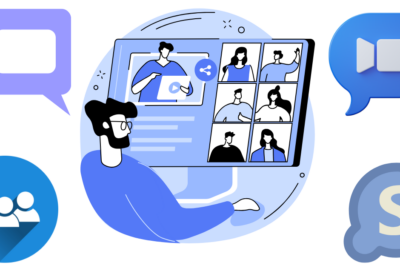Video Conferencing API: Revolutionizing Communication in the Digital Age
Imagine having the power to connect with people from around the world. Share ideas and collaborate seamlessly, all from the comfort of your space. That’s the magic of video conferencing, and it’s only getting better with the emergence of Video Conferencing API.
In this blog, we’re diving into Video Conferencing APIs and how they revolutionize our communication. Let’s learn and understand the basics to explore the latest trends and benefits. So, let’s embark on this journey together as we uncover the endless possibilities that Video Conferencing APIs bring to the table. Let’s enhance your business operations and connect with your loved ones across the globe.
Get ready to explore the exciting world of Video Conferencing APIs and their role in shaping the digital landscape. Are you ready to dive in? Let’s get started!
The Role of Video Conferencing in the Digital Age
The digital age has witnessed a remarkable shift in how communication takes place. Traditional face-to-face meetings have given way to virtual interactions, breaking geographical barriers and enabling real-time discussions. Remote work and virtual meetings are common, enabling teams to work together.
Understanding Video Conferencing API Integration: How It Works
Let’s understand the concept before delving into the benefits and trends of Video Conferencing APIs.
What’s an API?: A set of rules that allows one app to interact with another is known as an API (Application Programming Interface). It defines how data and requests should be exchanged between them. They bring the power of face-to-face conversations right where you need them. They make communication smoother and more convenient.
API integration refers to connecting different software applications to work together and share information seamlessly. It’s like making different tools or apps “talk” to each other so they can cooperate and perform tasks more efficiently.
Here’s a simple explanation of how API integration works:
Communication between Apps: Imagine you have App A and App B. App A needs some information from App B to complete a task. Instead of manually copying and pasting the data, App A uses App B’s API to ask for the specific data it needs.
Request and Response: App A sends a request to App B’s API, asking for the data it wants. This request includes details about what App A is looking for.
API Processing: App B’s API receives, understands, and processes requests. It fetches the requested data or performs the action asked for.
Sending Data Back: Once App B’s API has ready data, it responds to App A. This response contains the requested information.
Using the Data: App A receives the response from App B’s API and can now use the data to complete its task. It’s as if App A borrowed the information it needed from App B for a short time.
For example, consider using your Google account to sign in to various apps without creating a new account. API integration makes this possible, as these apps use Google’s API to verify your identity.
Benefits of Video Conferencing API
1. Seamless Integration:
Video conferencing APIs allow developers to seamlessly integrate video communication features into their existing applications, workflows, or platforms. This integration enhances user experience and encourages more engagement.
2. Customization:
APIs provide the flexibility to tailor the video conferencing experience to match the host application’s branding, design, and user interface. This customization helps maintain a consistent look and feel for users.
3. Scalability:
Video conferencing APIs are designed to handle many participants, making it easier to accommodate various use cases, from one-on-one meetings to large-scale webinars or virtual events.
4. Reduced Development Time:
Developers can leverage APIs to save time and resources instead of building video conferencing capabilities from scratch. This enables quicker deployment of video communication features to the market.
5. Cross-Platform Compatibility:
Many video conferencing APIs support multiple platforms, including web browsers, mobile devices, and desktop applications. This cross-platform compatibility ensures that users can connect from various devices seamlessly.
6. Rich Feature Set:
Video conferencing APIs often have comprehensive features, including video and audio calls, screen sharing, chat functionality, recording options, virtual backgrounds, and more. These features enhance collaboration and engagement during online meetings.
7. Reliability and Quality:
Reputable video conferencing APIs offer reliable connectivity and high-quality audio and video streaming. They are designed to minimize latency, buffering, and dropped connections, resulting in a smoother user experience.
8. Security and Privacy:
Video conferencing APIs provide security measures such as end-to-end encryption, access controls, and authentication mechanisms. These features help protect sensitive information and ensure user privacy during virtual interactions.
9. Global Reach:
Video conferencing APIs enable users to connect with individuals or teams worldwide without extensive travel. This global reach supports international collaboration and reduces geographical barriers.
10. Analytics and Insights:
Some APIs offer analytics and reporting features that provide valuable insights into usage patterns, user engagement, and overall performance. These insights help organizations make informed decisions to improve their virtual communication strategies.
11. Cost Efficiency:
When compared to developing and maintaining an in-house video conferencing solution, using an API can be more economical. While API providers handle the technical details, businesses may concentrate on what they do best.
12. Innovation and Future-Proofing:
Their providers continuously update and improve video conferencing APIs, ensuring that users can access the latest advancements in video communication technology without major updates or overhauls.
Newest Trends in Video Conferencing API
Hybrid Work Solutions:
With the rise of remote and hybrid work models, video conferencing APIs were evolving to support seamless integration between physical meeting rooms and virtual participants. These APIs were being designed to enhance collaboration between in-office and remote teams.
Integration with Collaboration Tools:
APIs for video conferencing were being integrated into popular collaboration and productivity products like project management software, document-sharing platforms, and messaging apps. This integration aimed to streamline workflows and enhance communication within existing ecosystems.
Interactive Webinars and Events:
Video conferencing APIs enabled interactive webinars and virtual events with features like audience engagement tools, polls, Q&A sessions, and breakout rooms. This trend catered to businesses and organizations hosting virtual conferences and workshops.
AI-Powered Features:
Artificial Intelligence (AI) was integrated into video conferencing APIs to provide features like automated transcription, real-time language translation, sentiment analysis, and intelligent noise reduction. These AI enhancements aimed to improve the overall meeting experience.
Enhanced Security Measures:
Video conferencing APIs prioritized encryption, access controls, and compliance to provide safe communication and prevent unauthorized access.
Virtual Backgrounds and AR Filters:
Video conferencing APIs incorporated augmented reality (AR) features, including virtual backgrounds and AR filters, to enhance the visual experience and allow users to customize their virtual meeting environment.
Low-Latency and High-Quality Streaming:
The demand for high-quality video and audio streaming with minimal latency drove the development of video conferencing APIs that optimized bandwidth usage while delivering excellent quality.
Adaptive Network Optimization:
Video conferencing APIs optimize video quality based on participant networks.. This ensured a smoother experience, even in challenging network environments.
Ecosystem Expansion:
Video conferencing APIs expanded their ecosystems by offering SDKs (Software Development Kits) for various programming languages and platforms. This makes developers integrate video conferencing into their applications.
Remote Work Analytics:
Video conferencing APIs were starting to provide analytics and insights into remote work patterns, user engagement, and meeting effectiveness. This data helped organizations make informed decisions about their virtual collaboration strategies.
Remember that technology trends can change quickly, so staying current on the latest advancements is critical by consulting reputable sources and industry professionals in video conferencing APIs.
Industries Leveraging Video Conferencing API
Education:
Educational institutions use Video Conferencing APIs to facilitate remote learning. Schools and universities integrate these APIs into their learning management systems, allowing teachers to conduct virtual classes, engage students through video discussions, and share educational content. Video Conferencing APIs also enable interactive virtual lectures, online tutoring, and collaborative projects, creating a dynamic and accessible learning environment for students of all ages.
Business and Corporations:
Video Conferencing APIs play a crucial role in the business world, especially with the rise of remote work. Companies integrate these APIs into their communication tools to host virtual meetings, team collaborations, and client presentations. This technology fosters seamless communication among remote and distributed teams, ensuring efficient collaboration, decision-making, and project management. Video Conferencing APIs also support webinars, training sessions, and cross-departmental discussions.
Finance and Banking:
Financial institutions use Video Conferencing APIs to offer virtual banking services and financial consultations. Customers can connect with advisors through secure video calls to discuss investment strategies, loan applications, account management, and other financial matters. Video Conferencing APIs enhance customer engagement, build trust, and provide a convenient way for clients to access financial advice without visiting physical branches.
Retail and E-Commerce:
Retailers utilize Video Conferencing APIs to enhance customer interactions and sales. Brands integrate video calls into their e-commerce platforms, allowing customers to connect with sales representatives for personalized shopping assistance virtually. Video Conferencing APIs enable virtual product demonstrations, sizing consultations, and real-time assistance, creating an immersive shopping experience that closely mimics in-store interactions.
Conclusion
APIs open up new options as we say goodbye to traditional gatherings. Imagine cross-border talks enabled by real-time language translation. Virtual classrooms allow students and teachers to share knowledge. E-commerce relies on human ties since customer help is virtual. Video Conferencing APIs will continue to innovate. APIs allow us to shape discussions and relationships, creating a global network.
Video Conferencing APIs interweave our communications through the digital age. They symbolize development, linking us across screens and bytes. As we enter this age of communication revolution, remember that the journey is as vibrant as the connections we make.
Let’s take the future one virtual chat at a time.
FAQs
What is the difference between a Video Conferencing API and a standalone video conferencing platform? A standalone video conferencing platform is a dedicated application for virtual meetings, while a Video Conferencing API allows these capabilities to be integrated into other software or applications.
Can Video Conferencing APIs be customized for specific business needs? Yes, Video Conferencing APIs offer customization options to tailor the conferencing experience according to the unique requirements of businesses.
Are Video Conferencing APIs suitable for small businesses as well?
Video Conferencing APIs are versatile and can be scaled to suit the needs of small businesses, enabling cost-effective communication solutions.
How do Video Conferencing APIs contribute to remote learning in education?
Video Conferencing APIs enable educators to conduct online classes and engage with students in real-time, fostering interactive and collaborative learning experiences.
What security measures are typically implemented in Video Conferencing APIs?
Security measures include end-to-end encryption, secure authentication, and access controls to ensure that meetings and discussions remain private and secure.





Comments are closed.